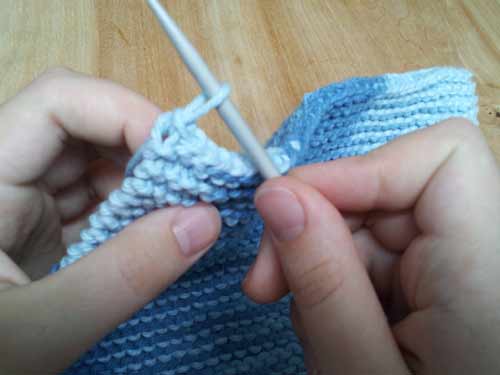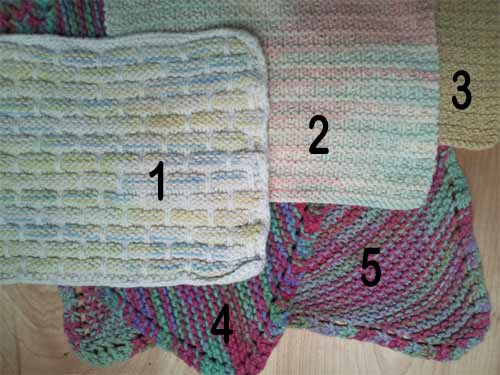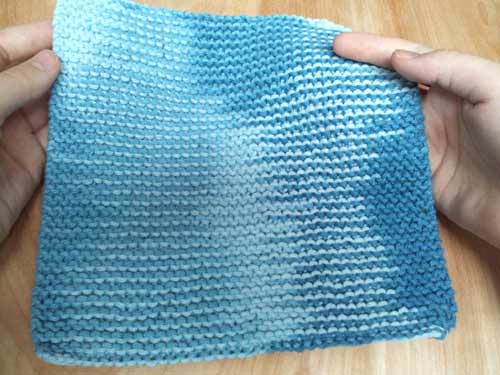
Have you ever thought, when your friends share great projects, “I wish I could knit”? You can! I have devised the simplest knitting project you are ever going to meet to help you knit a reusable cotton washcloth.
Like the best of punk music and country music: all you need is a red guitar, three chords, and the truth. In this case, all you need to make a profoundly useful and sustainable kitchen tool is cotton yarn, needles, three stitches, and a desire to make it yourself.
There are a lot more than three stitches in all of the fancy sweaters you see, and you will probably want to learn several more ways to do each of these stitches, but one way is enough for now. Just press on, and you will be wiping up with your own handiwork within hours.
Why Make Wash Cloths?
Knitters need to knit. Once you catch the bug, you will be looking for more and more projects to knit. Knitting your own washcloths keeps those knitting hands busy, but it also saves you money and lets you create exactly the color and style of cloths that you want to use. If you were looking for the right time to replace paper towels with reusable cloths, this is a quick and easy way to do it yourself. Plus, when people say, “Where did you get these great cloths?” you can then talk to them about your new hobby: knitting.
My mother made all of our wash cloths, and I’m still using those same cloths 30 years later. These are some of my very old kitchen cloths.

1. A popcorn pattern that is good for scrubbing
2 & 3. A flatter pattern that absorbs well
4 & 5. A nubby pattern that I think is the easiest to grip. I grab these first.
The Super Easy Pattern for a Knit Cotton Wash Cloth
- One skein of cotton yarn (Pictured is Lion Cotton Worsted Weight because that is what my local store carries.)
- Needles, size 7
- Tapestry needle
Cast on 40 stitches. Work every row knit (no purl), creating garter stitch. Knit until the whole piece is square then bind off and sew in ends.
That’s it! This sample took me about an hour and a half to finish.

There are a lot of fancy ways to make cloths with special stitches or crocheted edges, but I think plain garter stitch works best.
If you are new to knitting, I hope these photos will help.
| Cast On |
| Single Cast on (or backward loop cast on) is the simplest cast on. It isn’t elegant or fancy, but it is a fine way to start. There are many better ways to get this job done. You can think about those later. |




| Cast On, finish |



| Knit Stitch |
When I taught my children to knit, I used this simple rhyme to help them remember the steps to a knit stitch. It’s a common knitting teaching tool. Under the fence, catch the sheep, back we come, off we leap. Note: in the photos, my daughter knits holding the yarn in her right hand. I knit holding the yarn in my left hand (continental style). Either works. Do what feels most comfortable.




| Bind Off |
In this simple bind off, all you do is pass each loop over the next to give a finished appearance like a chain. It isn’t stretchy at all. You can learn many other binding off techniques that give your knitting more stretch, but this basic technique will serve you well.




| Finishing |
Once you finish knitting, you have just two tails to sew in for a tidy finish. I like to use a tapestry needle for this, but you can also use a crochet hook if you already have one.




| Finishing, sewing in Tails |




Resources
There are a lot of yarn stores online, but you probably have a local shop. Go there and talk to the owner. Ask about yarn. Ask about favorite needles. Ask about classes. Ask about knit nights. My local yarn shop has a late open night every Thursday where a dozen or so people sit around a table knitting, snacking, and just talking. You don’t get that shopping online, so find a local yarn store.
My favorite knitting site is Tech Knitting because the illustrations are absolutely clear (and often colorful). There is a lot of information on Tech Knitting, so check the index. As an example, this is the cast-on that I most often use.
When you become addicted and need a community, consider joining Ravelry, where you will find patterns, a personal notebook where you can record your stash and your projects, discussion groups, and friends.
My mother taught me to knit when I was 3 years old. I have been knitting steadily ever since. My husband and I talked about our favorite knitting yarns the first time we met. My mother knit my wedding shawl—a wedding ring shawl, it is called, because it is so fine that it can be pulled through a wedding ring. (I tried. It did work.) My husband, my mother, my mother-in-law, my baby, and I trekked to a knitting conference together to give the grandmothers a good excuse to spend time with their new granddaughter when she was very tiny. I taught my children to knit when they were small. Now, when we read school books aloud to one another, two of us knit while the other reads. (“Would you like to read now?” one asks. “Let me finish my row,” says everyone else.) I inherited a huge double cedar closet full of yarn, and we often, as we say, “go shopping” in my mother’s yarn closet. Currently, I am knitting dolls, my husband is swatching a new sweater, my 15-year old daughter is knitting a sweater from a 1939 pattern she tracked down after seeing it online, and my 12-year old son is knitting a cabled sweater. We are a knitting family.
I hope you have a great experience knitting this simple wash cloth. Even after all of the very complex knitting that I’ve done over the years, I loved knitting this simple piece. Let me know if you have questions.
Thanks to my daughter, the knitting hand model.
